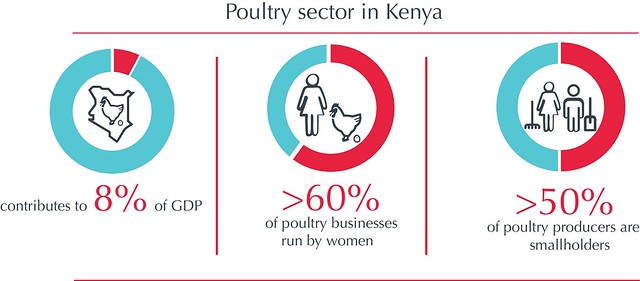
Improving control of a chicken disease supports the livelihoods of Kenya’s women
 Women play critical roles in the small-scale livestock systems that remain ubiquitous in the developing world. While these women typically face severe inequities in being able to own or even access land, capital and other productive resources, they often own or at least manage their household’s farm animals, particularly chickens and other small stock. Requiring little space and start-up capital, poultry farming in Kenya is growing rapidly and remains largely dominated by women, who typically invest most of their earnings in feeding their families and educating their children. That is why controlling major poultry diseases, which can wipe out whole flocks, is so important.
Women play critical roles in the small-scale livestock systems that remain ubiquitous in the developing world. While these women typically face severe inequities in being able to own or even access land, capital and other productive resources, they often own or at least manage their household’s farm animals, particularly chickens and other small stock. Requiring little space and start-up capital, poultry farming in Kenya is growing rapidly and remains largely dominated by women, who typically invest most of their earnings in feeding their families and educating their children. That is why controlling major poultry diseases, which can wipe out whole flocks, is so important.
Infectious bursal disease is an acute, highly contagious, viral disease of young chickens. The bursa is a specialized organ in birds, located at the hindgut, necessary for development of the immune system’s B cells. The disease causes small-scale poultry farmers huge economic losses, both from the many birds that die outright and from lost productivity among surviving birds. Suffering from immunosuppression, surviving chickens become susceptible to other diseases and do not respond well to vaccination. In the last five years, infectious bursal disease has been detected among vaccinated chickens, causing frustration among farmers. The disease has forced many Kenyan farmers out of the poultry business altogether, seriously damaging their livelihoods.

Alleviating the prevalence of chicken diseases builds the resilience of livestock farmers living in extreme poverty, Kenya (Photo credit: ILRI/Bethlehem Alemu and Apollo Habtamu)
To understand why vaccinated birds were getting the disease, Jane Githinji, head of the virology laboratory at the Central Veterinary Laboratory in Kenya’s Directorate of Veterinary Services, needed advanced DNA sequencing and bioinformatics platforms to compare the molecular makeup of the circulating virus strains causing infectious bursal disease in Kenya with the ones used in the commercial vaccines. In December 2015, she was awarded an African Biosciences Challenge Fund research fellowship at the Biosciences eastern and central Africa-International Livestock Research Institute (BecA-ILRI) Hub, one of the few advanced facilities on the continent supporting African and other institutions conducting research on agricultural productivity, food safety and nutritional security. Over the next 12 months, Githinji gained access to technologies, received training and, most of all, support from an international community of bioscientific expertise.
Working closely with scientists from ILRI and the University of Nairobi, Githinji found that some of the virus strains in Kenya’s bird populations were far more genetically diverse than previously believed. During her genetic analysis of the virus strains, the first molecular characterization of the infectious bursal disease in Kenya, Githinji also discovered unique amino acids in some of them. Using a technique known as reverse transcription polymerase chain reaction to replicate a DNA segment from the virus, Githinji designed a diagnostic tool with which to characterize and detect virus variants. While further research is needed to verify the efficacy of existing vaccines, this breakthrough allows for more effective tests for infectious bursal disease.
The Directorate of Veterinary Services—responsible for animal health policy formulation and regulation in Kenya—will now be able to use the findings to develop improved vaccination, surveillance and control strategies for infectious bursal disease, such as procedures for virus diagnosis. For instance, if deployed at border inspection posts, the tool would help prevent the importation of infected chickens. Githinji also plans to share the knowledge and methodological approaches acquired at the BecA-ILRI Hub with her colleagues as is it also applicable to the study of other livestock diseases.
Wellington Ekaya, head of capacity development
Roger Pelle, principal scientist, molecular parasitologist
This article was published in the ILRI Corporate report 2016—2017. Download the full report here: http://hdl.handle.net/10568/92517
Partners: Directorate of Veterinary Services, Kenya; University of Nairobi
Investors: Bill & Melinda Gates Foundation; Commonwealth Scientific and Industrial Research Organisation; Department for International Development, United Kingdom; Swedish International Development Cooperation Agency; Syngenta Foundation for Sustainable Agriculture



















